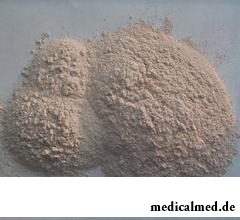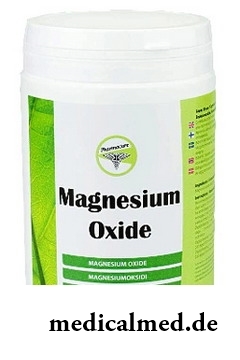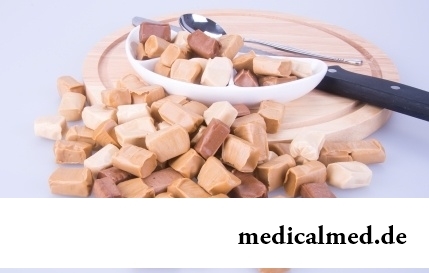





Magnesium oxide
Magnesium oxide (MgO) – white hydroscopic solid minerals which meet in the nature in the form of a periclase and are a magnesium source.
Receiving magnesium oxide is possible when roasting minerals of magnesite and dolomite.
magnesium oxide is possible when roasting minerals of magnesite and dolomite.
In vitro receiving magnesium oxide happens by magnesium carbonate processing by magnesium chloride to lime and the subsequent thermal treatment.
Properties of magnesium oxide
Magnesium oxide – inodorous white powder soluble in acid and ammonia and insoluble in alcohol.
Molecular formula of magnesium oxide – MgO, molar weight – 40,3044 g/mol, density – 3,58 g/cm ³, melting temperature – 2852 °C, 3125 K, 5166 °F, boiling temperature – 3600 °C, 3873 K, 6512 °F, solubility in water – 0,0086 g / 100 ml (30 °C).
Magnesium oxide use
In traditional medicine magnesium oxide is used as mineral additive for prevention and treatment of deficit of magnesium in blood. Magnesium is very important component for normal functioning of cells, a nerve, muscles, bones and heart.
As a rule, well balanced diet provides the normal content of magnesium in blood. However as furosemide and a hydrochlorothiazide, gastrointestinal diseases, bad food, alcoholism and a diabetes mellitus lead reception of such medicines to development of deficit of magnesium in an organism.
Antiacid properties of magnesium oxide help at a gastric disturbance, a hyperoxemia of a stomach and heartburn, neutralizing acidity of a stomach. Also magnesium oxide is applied as laxative at treatment of stomach ulcer, a duodenum and stones of calcium oxalate in kidneys.
Magnesium oxide is a part of medicines and nutritional supplements which effect is directed to completion of deficit of magnesium in an organism. Medicine on the basis of magnesium oxide is taken inside, it is desirable during food to exclude a gastric disturbance and diarrhea. It is necessary to accept drugs regularly at the same time, for obtaining the maximum advantage. The dosage depends on the state of health and reaction to treatment.
The magnesium oxide surplus in blood can result in serious side effects. Before accepting additives which part magnesium oxide is medical consultation as they can contain inactive components, which defiant allergic reactions is necessary.
As an industrial component magnesium oxide is used in production of paper, magnesian salts (Epsom salt), acetates, chlorides and as a component in some types of cement.
In the fiber glass industry magnesium oxide is used in processing of steel and nickel.
Magnesium oxide is a part of insulators of industrial cables as the main fire-resistant material for crucibles and as the main component in production of fire-resistant construction materials. It is widely used in heating systems as a component of heating elements of tubular designs.
The pressed crystals of magnesium oxide are used in production of optical material. They are transparent from 0,3 to 7 microns and possess a good indicator refraction 1,72 at 1 micron, and also have low cost.
Magnesium oxide is used at the recycling plants as substance capable to control solubility of radionuclides.
Also oxide magnesium it is used as a sheeting for plasma displays, and athletes use magnesium oxide powder as white topping for hands thanks to which they do not slide on apparatuses.
In the industry magnesium oxide is applied to production of rubber, synthetic rubbers and purification of oil products, and in electronic industry it is used as an abrasive for cleaning of surfaces.
In the food industry magnesium oxide is known as E530 nutritional supplement – the emulsifier which is not dissolved in water which is used in production:
- Powdered milk;
- Cream powder;
- Chocolate;
- Cocoa;
- Edible oils.
Contraindications and harm of magnesium oxide
Reception of medicines on the basis of magnesium oxide can lead to gastric disturbances and a diarrhea, serious allergic reactions (rash, an itch and hypostases in particular in a face, language and a throat), to urticaria, severe dizzinesses, spasms, differences of mood, weakness, nausea, vomiting, fatigue and trouble breathing.
Drugs on the basis of magnesium oxide with care are appointed at a disease of kidneys, during pregnancy and in the period of a lactation.
Medicines  in the form of liquids and powders which part magnesium oxide is also may contain sugar and sweetener aspartame. Liquids can also contain alcohol. They with caution should be taken at such diseases as diabetes, alcohol addiction, liver diseases, a fenilketonuriya and at any other diseases which treatment demands restriction of these substances in a daily diet.
in the form of liquids and powders which part magnesium oxide is also may contain sugar and sweetener aspartame. Liquids can also contain alcohol. They with caution should be taken at such diseases as diabetes, alcohol addiction, liver diseases, a fenilketonuriya and at any other diseases which treatment demands restriction of these substances in a daily diet.
Reception of magnesium oxide is contraindicated at the use of cellulose of sodium of phosphate, digoxin and polistirolsulfanat of sodium.
Magnesium oxide can neutralize completely action of such medicines as:
- Tetracyclines (demeclocycline, doxycycline, minocycline and tetracycline);
- Bisfosfonata (алендронат); Thyroid
- gland drug (left thyroxine);
- Antibiotics (ciprofloxacin, levofloxacin).
Uses of magnesium oxide can cause slight irritations of skin and eyes. Inhalation of powder of magnesium oxide can cause irritation of a nose and throat, and steam inhalation of magnesium oxide can cause a condition of the foundry fever accompanied with such symptoms as metal smack in a mouth, irritation of a throat, dry cough, increase in leukocytes in blood, a fever and weakness of muscles.
Human bones are stronger than concrete four times.

Neurosis is called pathology of a nervous system at which deviations in functioning of the highest nervous processes are observed. Nye...
Section: Articles about health
What is in our understanding weeds? It plants which are considered to be suitable only for compost pits and feeding of animals. Meanwhile, among the weeds growing literally under legs it is possible to find the mass of the officinal herbs possessing invaluable Paul...
Section: Articles about health
From sexual contacts each person can test insufficiently strongly expressed sexual desire or lack of satisfaction from time to time. However when it happens regularly, it is an occasion to think about health. Most of people does not hurry to ask similar questions physicians: one consider that they will be able to cope with malfunctions independently, others hesitate to report to strangers about so delicate problems and hope that troubles will stop by itself....
Section: Articles about health
Separate food - the system of meal based on digestion physiology which is carried to improvement methods. In opinion д...
Section: Articles about health
The main role in development of a peptic ulcer of a stomach and duodenum the bacterium Helikobakter plays pilor. Activity and the strengthened reproduction of this microorganism lead to weakening of protection of mucous membranes and their erosive damage. Manifestations not...
Section: Articles about health
(Xerostomia) many people consider feeling of a xerostomia small and easily removable inconvenience. This delusion: the symptom can demonstrate existence of serious diseases. It is worth to remember also that saliva performs important functions in an organism: clears the surface of teeth of a food plaque, growth of pathogenic microorganisms oppresses, normalizes acid-base balance, liquefies food and helps to split the carbohydrates which are contained in it. Chronic deficit слюн...
Section: Articles about health
The person, as well as all other beings living on our planet feels weather changing. It is normal meteosensitivity, not...
Section: Articles about health
The thought that the mass of their body is too big at least once in life visits from 80 to 95% of women. Many women are so obsessed with this idea that constantly try all new and new ways of weight reduction. Considerable part of these method...
Section: Articles about health
Tick-borne encephalitis – one of the most dangerous viral diseases which causative agents transfer and is given to people by ixodic mites. These are the small blood-sicking insects living in the considerable territory of our country. The person bitten by a tick can catch also erlikhiozy, bartonnelezy, babeziozy, mycoplasmosis and Lyme's disease. As well as encephalitis, these illnesses affect the central nervous system, and as specific antiviral therapy does not exist, the forecast very to a neuta...
Section: Articles about health
For many spouses the question of planning of a family is one of the main. The choice problem effect at the same time comes out on top...
Section: Articles about health
Food with the increased content of sugar is attractive to most of people - it is scientifically confirmed fact. Business here not in intemperance or dissoluteness: the sweet food is associated since childhood with feeling of rest and safety which is felt by the kid, to...
Section: Articles about health
All know that self-treatment is dangerous. However absolutely it is almost impossible to do without it. Rate of modern life does not allow to handle each small trouble to the doctor and information on ways of independent delivery of health care is quite available. Means, all of us have only one: to learn to give this help competently and in those limits in which it is possible for the person who does not have vocational education....
Section: Articles about health
Each failure in work of bodies and systems of a human body is, as a rule, shown by the whole complex of symptoms. In particular, N...
Section: Articles about health
The healthy nutrition is the invariable principle of health and good health for long years of the woman. Nevertheless, in a diet at each stage of life there are the features allowing to support an organism by those substances which are most necessary...
Section: Articles about health
All of us, unfortunately, should face flu nearly an every year. It would seem, so frequent disease has to be studied already up and down, and each person, at least once to them had (and the number of such people in our country aims at 100%), has to know the basic rules of its treatment. However as shows experience of doctors, there is no it, and often people, self-confidently thinking what is known as it is necessary to be treated, make mistakes....
Section: Articles about health
For most of the working people the problem of having a snack is particularly acute enough. Sooner or later there is a question: what is possible quickly for a sja...
Section: Articles about health
The saying "the rich do not know how the other half lives" is known to all. In a broad sense it is that we can not always understand the person whose features of a state are unknown to us. If with physiological characters of diseases the situation is more or less clearly (having noticed and...
Section: Articles about health
Statistically, can only one of ten of our compatriots brag of a decent condition of an oral cavity. Six teeth affected with caries are the share of the average Russian. For comparison, this indicator for Europeans is almost six times less....
Section: Articles about health
Bulimia and anorexia, are heavy deviations of a feeding behavior, become a cause of death of patients much more often than all others...
Section: Articles about health
Dark circles (bruises) under eyes – a shortcoming with most of which often fight against the help of cosmetics (proofreaders, saloon procedures and so forth), eliminating only its visibility. However, according to doctors, skin around eyes – the indicator of many disturbances in an organism...
Section: Articles about health
According to data of World Health Organization, the cataract is diagnosed almost for 7% of the population of Earth. The statistics of incidence is considered not full as at an initial stage the illness, as a rule, does not cause to the person of special inconveniences, and many diseased sees doctors not at once. The cataract is not only one of the most widespread ophthalmologic illnesses, but also the reason of a half of cases of loss of sight....
Section: Articles about health
Life of the modern woman is very difficult. Opportunities to realize itself are wide: it not only education and career, but also most differently...
Section: Articles about health
Sugar - the digestible refined product which is not of special value for an organism of the modern person. The use of sugar in food is based rather on the psychological dependence caused by desire to indulge itself with something tasty, and in дальнейш...
Section: Articles about health
The mankind knows that some toxins at intake in the minimum quantities have therapeutic effect from an extreme antiquity. Many substances recognized poisonous are applied in the medical purposes also today, being the main operating components of the medicines which are officially produced by pharmaceutical industry. Let's tell only about the most known of them....
Section: Articles about health
What woman does not dream of a beautiful and thick hair? So far physicians developed difficult schemes on hair transplant, in the bet industry...
Section: Articles about health
Statistically cystitis 25-30% of women up to 40 years have. With age this indicator raises, besides many do not get to statistics because do not see a doctor. The most sad that after the regular visits to doctors, long reception of antibiotics...
Section: Articles about health
Almost each of us during life faced dissatisfaction with own body. At such moments, as a rule, we begin to shame ourselves, urgently we go on the most rigid diet promising minus of 10 kg in a week, or we exhaust ourselves in the gym to almost death. As a rule, similar attempts come to an end with a campaign to the refrigerator for jamming of the next stress. Further history repeats itself with individual frequency....
Section: Articles about health
